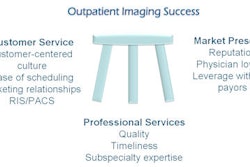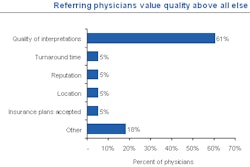A new legal opinion issued by the U.S. Department of Health and Human Services' Office of Inspector General (OIG) has some imaging industry observers wondering if the OIG has unwittingly created a loophole regarding preauthorization -- one that may require many imaging practices to contract with preauthorization outsourcing firms to maintain their referral base.
Requiring preauthorization for imaging services may be anathema to radiologists and a hassle for referring physicians, but the concept is gaining traction in the U.S. among private and government payors desperate to find ways to clamp down on overutilization of advanced imaging services such as MR, CT, and PET.
The trend is so powerful that it has given rise to a cottage industry of firms devoted to preauthorization outsourcing. These firms contract with referring physicians and handle many of the hassles of preauthorization, such as forwarding patient data to private payors and radiology benefits management (RBM) firms, waiting on the phone for approvals, and so on.
But there's been some concern that providing preauthorization outsourcing services could put referring physicians and imaging facilities in conflict with federal antikickback rules, which prohibit the transfer of cash or services in exchange for patient referrals. To clarify the situation, one preauthorization firm sought to obtain a legal opinion from the OIG on the kickback issue.
The firm told the OIG that it plans to form and manage a company that would contract with imaging facilities to process and submit preauthorization claims from each facility's referring physicians for medical imaging procedures. The imaging facility would provide the company with the patient information needed to submit the preauthorization and would pay a fee for the service, whether or not the patient's insurer granted approval for the test.
In essence, imaging facilities using the service potentially would have a competitive advantage over those that are not because their referring physicians would no longer have to handle preauthorization themselves.
In a September 26 advisory opinion, the OIG said that the proposed arrangement would not violate antikickback rules for the following reasons:
- The new company would not be a healthcare provider, practitioner, or supplier, and plans to provide administrative services at a fair market rate.
- Being administrative, the proposed arrangement doesn't include marketing services, which by definition promote a particular item or service: the preauthorization company wouldn't have contact with patients.
- The new company would not be providing services on behalf of a supplier such as an imaging company or manufacturer to an existing or potential referral source, but rather to insurers and their members.
"We conclude that the proposed arrangement would not generate prohibited remuneration under the antikickback statute," the OIG wrote.
Flawed opinion?
But the advisory has serious flaws, according to Thomas Greeson, a partner at Reed Smith of Falls Church, VA, who specializes in radiology-related regulatory matters. Missing from the advisory is clarity about which player in the imaging transaction -- the referring physician or the imaging center -- has contractual obligation for getting preauthorization.
"I'm troubled by this opinion," Greeson said. "Many, if not most, private payor contracts vest the referring physician with the responsibility for obtaining the preauthorization approval for advanced imaging studies. This opinion fails to comprehend that referring physician groups will naturally seek out and refer to those centers that relieve them of their payor contract obligation to obtain preauthorization."
The American College of Radiology (ACR) shares this concern, according to Thomas Hoffman, associate general counsel at the ACR.
"Although ACR has no official position on preauthorization, it's keenly aware of the issue," Hoffman said. "This opinion doesn't address who does the preauthorizing -- referring physicians or radiologists."
By the OIG's own admission, the opinion does seem to play into kickback scenarios, according to Scott Garrett, corporate compliance officer at PresGar, an imaging services provider based in Tampa, FL.
"When an imaging center provides non-Medicare preauthorizations for referring physicians, using a service like the one described in the opinion, it takes the responsibility off of the physician's shoulders," Garrett said. "If Medicare referrals result in return for providing this 'service' to the referring physician, antikickback could be implicated."
The OIG's advisory could set a precedent that would require all imaging centers to have an agreement with a preauthorization outsourcing company or lose patient referrals. And that could affect patient care: With referring physicians out of the loop on the appropriateness of the study, care decisions could be made not on a quality basis, but on how convenient they are, according to Deborah MacFarlane of HealthEdge, a radiology practice consulting firm based in San Diego.
"This advisory opens the door to further legitimize scan brokers," MacFarlane said. "It's basically saying that third-party companies can obtain the authorization and charge the imaging center for doing so."
Another issue in the advisory, according to Greeson, is the problem of determining if the service is "for or on behalf of" a referring physician.
"Is the service not 'on behalf of' the referring physician if there is no agreement with that person, or actual knowledge that the imaging center is relieving him or her of this administrative burden?" Greeson said. "It strikes me that this will create a 'don't ask, don't tell' policy."
The OIG's advisory opinions are intended only for the firm that requested them and are not meant to be widespread policy. But that doesn't prevent other facilities from reading them and acting accordingly, according to Greeson.
"The OIG's opinions don't relate to other arrangements -- they're only binding for the requestors," he said. "But they are extremely influential. It's hard to ignore an advisory opinion."
By Kate Madden Yee
AuntMinnie.com staff writer
October 7, 2008
Related Reading
GAO: DRA cut 2007 imaging expenses by $1.7 billion, September 26, 2008
GAO report on overutilization draws industry ire, July 15, 2008
Want to survive in a post-DRA world? Start talking, March 4, 2008
Copyright © 2008 AuntMinnie.com



















